Sensory Timers: Discover the Benefits

Explore Our Range of Sensory Timers:
Time Timer (20cm)

31 in stock
$65.00
Easy-to-Use Interface
Visual Countdown Display
Durable Construction
Portable Design
Time Timer PLUS

57 in stock
$80.00
Easy-to-Use Interface
Adjustable Volume Settings
Customizable Time Intervals
Portable Design
Portable Schedule with Digital Sensory Timer

$24.95
Easy-to-Use Interface
Digital Countdown Display
Customizable Time Intervals
Notifications before time is up
Liquid Sensory Timers:

39 in stock
$15.95
Easy-to-Use Interface
Portable Design
Customizable Time Intervals
Durable Construction
Time Management = Anxiety Management
Without such accommodations, students may frequently interrupt lessons, seeking reassurance about the time or what happens next. This is particularly problematic when phones, which some rely on for timekeeping, are banned in schools. By offering students tools like visible clocks, sensory timers, or scheduled visual aids, schools can help them manage their time more effectively. These adjustments can range from simple solutions, like placing a digital clock in the classroom, to more personalized supports, such as giving students individual time timers.

Applying Sensory Timers Effectively
Step 1
Select the Appropriate Timer
Choose one of our sensory timers that fits the child’s needs. If they’re more comfortable with digital time, opt for a digital timer that counts up or down. For visually-driven learners, a liquid timer or a visual time timer can be beneficial as it shows the passage of time in a tangible way (e.g., the liquid moving down or the red area shrinking).
Step 2
Introduce the Timer and Activity
Clearly explain how long an activity will last by setting the timer. For example, if the child needs to focus on reading for 10 minutes, set the sensory timer to visually display the countdown. Liquid timers can also be used for short breaks, encouraging the child to return when the liquid has dripped through.
Step 3
Use Timers to Support Transitions
As the sensory timers wind down, use it to cue transitions between tasks. For instance, use a liquid timer to help them “wait” for their turn or to mark the end of one activity and the start of another. For children who might become anxious if time runs out, incorporate a “Plan B” such as resetting the timer or making a plan to finish later.


 Sorry we no longer ship items outside Australia. Please consider the digital versions of Sue’s Books –
Sorry we no longer ship items outside Australia. Please consider the digital versions of Sue’s Books – 